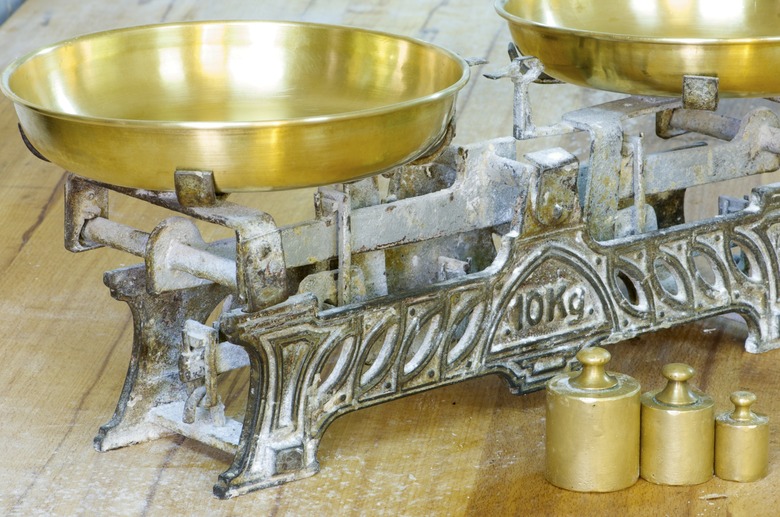How To Solve Pan Balance Problems
Pan balance problems are algebra problems with equations represented by a pan balance, which is a type of scale. Shapes such as squares or circles or objects such as cubes or cones represent the unknowns — the answers you need to find — and pan weights with numbers on them represent the constants. A level balance represents two sides of an equation with an equal sign between them. The pan balance picture provides a visual cue for understanding the purpose of the equal sign.
Step 1
Learn how pan balances work. Place an object on one side and place weights on the other side until it balances and the two pans are level with each other. Then add up the numbers on the weights to learn the weight of the object. For example, if you put an apple on one side of the scale, and then add a 100-gram weight and two 20-gram weights on the non-apple side of the scale to make it balance, the apple weighs 140 grams. Write this equation as "apple weight = 140 grams."
Step 2
Assess the problem and simplify the shapes or objects, if possible. Look for situations in which the same objects are on both the left and right side of the balance. Cross out the same number of that object on each side of the balance. For example, if a balance has two cubes on the left side and three cubes on the right side, cross out two cubes on each side, leaving only one cube on the right side. This works because you're removing the same weight from both sides, and the balance will stay level. Repeat for all objects and for all balances in your problem.
Step 3
Simplify the numbers. If numbered weights appear on both sides, cross out equal numbers on both sides. For example, if your balance shows a 3-gram weight on the left side and one or more 3-gram weights on the right side, cross out one 3-gram weight on each side. Repeat for all weights, if you have a set of balances in your problem.
Step 4
Create an equation or a series of equations from your simplified balances. Use variables like x, y or c to represent the objects. For example, if your picture shows three cubes and a 3-gram weight on the left side, and one 9-gram weight on the right side, your equation would look like this: 3x + 3 = 9.
Step 5
Continue solving as you normally would solve an equation or set of equations, always by doing the same thing to both sides of an equation, until you have an answer for the unknowns.
TL;DR (Too Long; Didn't Read)
When solving these problems, especially multiple equation problems, always keep both sides of the balance level by doing the same thing to both sides.
Cite This Article
MLA
Cavanagh, Coral. "How To Solve Pan Balance Problems" sciencing.com, https://www.sciencing.com/solve-pan-balance-problems-7266667/. 24 April 2017.
APA
Cavanagh, Coral. (2017, April 24). How To Solve Pan Balance Problems. sciencing.com. Retrieved from https://www.sciencing.com/solve-pan-balance-problems-7266667/
Chicago
Cavanagh, Coral. How To Solve Pan Balance Problems last modified August 30, 2022. https://www.sciencing.com/solve-pan-balance-problems-7266667/
